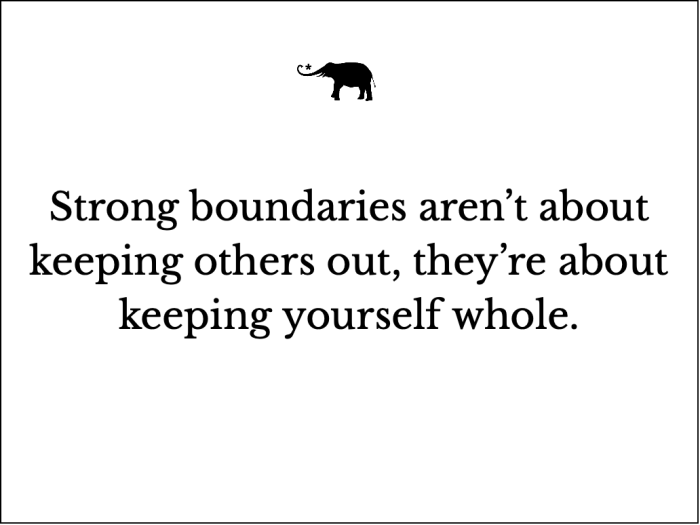View this post on Instagram
If you’re highly sensitive, chances are you’ve felt like you’re on an emotional rollercoaster, even when things around you seem calm.
You might feel drained by the end of the day, having unknowingly absorbed the emotions or energy of others. The truth is, being highly sensitive can be both a gift and a challenge, and without strong energetic boundaries, you may experience chronic overwhelm or burnout.
Burnout often sneaks up on highly sensitive individuals (HSPs) not because they’re doing too much physically but because they’re constantly spongeing and carrying energy that doesn’t belong to them. This can lead to exhaustion, anxiety, and feeling emotionally depleted.
However, energetic boundaries—those invisible but powerful lines that separate your energy from others—can help prevent burnout by protecting your emotional and mental space. By creating these boundaries, you not only preserve your energy but allow yourself to thrive.
Here are three distinct ways to elevate your energetic boundaries and prevent burnout in a grounded, practical way.
(1) Create a Daily Energy Check-in to Establish Your Baseline
One of the most important steps for any highly sensitive person is knowing their baseline energy state. Think of this as your personal “home base”—the emotional, mental, and physical state you naturally exist in before interacting with others or taking on tasks. Checking in with this baseline in the morning allows you to have something to reference throughout the day. If you notice your energy has shifted or you’re feeling drained, you can trace it back to specific interactions or situations and reset.
How to do it:
>> Morning Baseline Check-in: Start your day with a quiet, 5-minute energy check. Sit down, close your eyes, and ask yourself: “How am I feeling right now, before the day starts? What’s my baseline emotional and physical state?”
>> Midday: Anytime you feel drained, stressed, or “off,” refer back to your baseline state. Compare how you felt in the morning to how you feel now. This will help you recognize when something or someone is pulling on your energy.
Journal Prompts to Identify the Source of Energy Drain:
>> “What interactions or tasks today may have caused my energy to dip?”
>> “How did I feel after spending time with a particular person or group?
>> “Am I holding onto someone else’s emotions or problems right now?”
Once you identify the source of the energy drain, take one small action to shift your energy. It could be as simple as stepping outside for fresh air, setting a boundary for the rest of the day, or practicing a quick breathing exercise.
(2) The Conscious Pause and 24-Hour Rule
Highly sensitive people often feel the need to respond to requests immediately, whether it’s a friend asking for help or a colleague seeking advice. However, learning to pause consciously before responding can help you avoid overcommitting and taking on more than you can handle.
The Conscious Pause is all about creating space between the request and your response. Instead of rushing to say “yes” or feeling uncomfortable with silence, allow yourself to take a beat. Give your body the chance to assess how the request feels before you respond.
How to do it:
Conscious Pause: When someone asks something of you, take a moment to pause. You can say something like, “Let me think about that,” or simply take a few deep breaths to tune into how you feel. How does the request sit in your body? Do you feel open and expansive, or tight and resistant?
24-Hour Rule: sleep on it! If you’re unsure, tell the person you’ll get back to them in 24 hours. This not only gives you time to make an aligned decision but also trains you to stop responding out of obligation or pressure.
Quick Breakdown of the 24-Hour Rule:
-
- Receive the request.
- Take 30 seconds or more to pause and reflect.
- If unclear, ask for 24 hours to decide.
- Check in with how the request feels in your body.
- Make a decision after considering your energy levels and capacity.
Giving yourself this space to pause allows you to make more empowered choices, keeping your energy intact.
(3) Track Your Energy: The Energetic Budget Exercise
A key way to prevent burnout is getting clear on your energy deposits and withdrawals—where your energy is spent and where it is replenished. Think of your energy like a financial budget. Just as you wouldn’t spend all your money without knowing how much you have, you shouldn’t spend your energy without being clear on how much you’re giving and receiving.
How to do it:
>> Create two columns in a journal: One for “Deposits” (things that recharge you) and one for “Withdrawals” (things that drain you).
>> Deposits: Write down everything that brings you energy—whether it’s time alone, meditation, certain people, creative projects, or time in nature.
>> Withdrawals: List the people, tasks, or environments that drain you, no matter how small. These could include work meetings, social obligations, or even certain phone calls.
Once a week, review your energy budget: Are there more withdrawals than deposits? What can you adjust to restore balance? This understanding will help you set appropriate boundaries and ensure you’re not overspending your energy.
For highly sensitive individuals, burnout often happens not because of physical exhaustion but because of emotional and energetic overwhelm. By elevating your energetic boundaries through daily check-ins, conscious pauses, and understanding your energy budget, you can create space to recharge and protect your emotional wellbeing.
These practical, grounded steps will allow you to live in alignment with your sensitivities, maintaining your energy without feeling drained or burnt out. Remember, protecting your energy isn’t selfish—it’s necessary for thriving and being able to show up fully in your life.
~

 Share on bsky
Share on bsky







Read 4 comments and reply